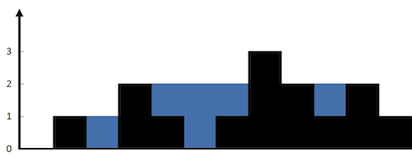Problem:
Given n non-negative integers representing an elevation map where the width of each bar is 1, compute how much water it can trap after raining.
Input and output examples
Example 1:
Input: height = [0,1,0,2,1,0,1,3,2,1,2,1]
Output: 6
Explanation: The above elevation map (black section) is represented by array [0,1,0,2,1,0,1,3,2,1,2,1]. In this case, 6 units of rain water (blue section) are being trapped.
Example 2:
Input: height = [4,2,0,3,2,5]
Output: 9
Constraints:
n == height.length
1 <= n <= 2 * 104
0 <= height[i] <= 105
Solution
class Solution(object): |
Test the the solution:
s = Solution() |
More interview questions can be found here:
Algorithm

